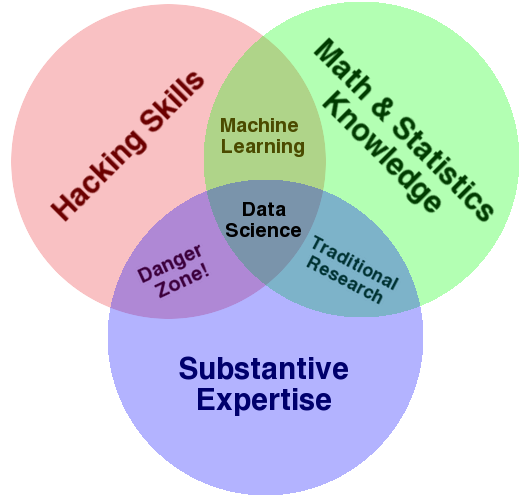Travels with R and Python
the power of data science in healthcare
Aug 2, 2023
What is data science?
- “A data scientist knows more about computer science than the average statistician, and more about statistics than the average computer scientist”
Drew Conway’s famous Venn diagram

What are the skills of data science?
- Analysis
- ML
- Stats
- Data viz
- Software engineering
- Programming
- SQL/ data
- DevOps
- RAP
What are the skills of data science?
- Domain knowledge
- Communication
- Problem formulation
- Dashboards and reports
Stats and data viz
- ML leans a bit more towards atheoretical prediction
- Stats leans a bit more towards inference (but they both do both)
- Data scientists may use different visualisations
- Interactive web based tools
- Dashboard based visualisers e.g. {stminsights}
Software engineering
- Programming
- No/ low code data science?
- SQL/ data
- Tend to use reproducible automated processes
- DevOps
- Plan, code, build, test, release, deploy, operate, monitor
- RAP
- I will come back to this
Domain knowledge
- Do stuff that matters
- The best minds of my generation are thinking about how to make people click ads. That sucks. Jeffrey Hammerbacher
- Convince other people that it matters
- This is the hardest part of data science
RAP
- Data science isn’t RAP
- RAP isn’t data science
- They are firm friends
Reproducibility
- Reproducibility in science
- The $6B spreadsheet error
- George Osbourne’s austerity was based on a spreadsheet error
- For us, reproducibility also means we can do the same analysis 50 times in one minute
- Which is why I started down the road of data science
What is RAP
- a process in which code is used to minimise manual, undocumented steps, and a clear, properly documented process is produced in code which can reliably give the same result from the same dataset
- RAP should be:
the core working practice that must be supported by all platforms and teams; make this a core focus of NHS analyst training
Levels of RAP- Baseline
- Data produced by code in an open-source language (e.g., Python, R, SQL)
- Code is version controlled
- Repository includes a README.md file that clearly details steps a user must follow to reproduce the code
- Code has been peer reviewed
- Code is published in the open and linked to & from accompanying publication (if relevant)
Levels of RAP- Silver
- Code is well-documented…
- Code is well-organised following standard directory format
- Reusable functions and/or classes are used where appropriate
- Pipeline includes a testing framework
- Repository includes dependency information (e.g. requirements.txt, PipFile, environment.yml)
- Data is handled and output in a Tidy data format
Levels of RAP- Gold
- Code is fully packaged
- Repository automatically runs tests etc. via CI/CD or a different integration/deployment tool e.g. GitHub Actions
- Process runs based on event-based triggers (e.g., new data in database) or on a schedule
- Changes to the RAP are clearly signposted. E.g. a changelog in the package, releases etc. (See gov.uk info on Semantic Versioning)
Data science in healthcare
- Forecasting
- Stats versus ML
- Text mining
- R versus Python
- Demand modelling
- DevOps as a way of life
Get involved!
- NHS-R community
- Webinars, training, conference, Slack
- NHS Pycom
- ditto…
- MLCSU GitHub?
- Build links with the other CSUs
Contact
view slides at the-strategy-unit.github.io/data_science/presentations